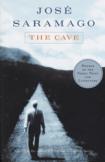Excavating Plato
The comedian Steve Martin once quipped that the problem with studying philosophy in college is that later in life one always remembers just enough of it to make one’s conscience uncomfortable. In his new novel, The Cave, Nobel laureate José Saramago hearkens back to perhaps the best known and most widely taught philosophical fable, the allegory of the cave from Plato’s The Republic, to offer some deeply unsettling implications for our own time and culture.
Saramago focuses on Cipriano Algor, a 64-year-old widower who lives with his daughter and her husband in an unnamed, desolate country. The Algors’ economic lives revolve in large part around The Center, a sprawling, self-enclosed world of commerce, recreation and regimented apartment living. (Picture the Mall of America transmogrified into a Kafkaesque living community.) Residing just outside the Center precincts, Cipriano makes a modest living supplying pottery to the Center, until he is informed that his plates, dishes and pitchers are to be replaced by plastic products. Cipriano and his daughter devise a new line of products and eventually agree to move into the Center.
Saramago invests the Center with a number of sinister features. Its windows cannot open, and Center officials continuously spout pseudo-koans such as, “The secret of the bee doesn’t exist, but we know what it is.” Perhaps the secret is that the hive-like behavior of the Center’s inhabitants emerges from a profoundly uncritical loyalty. Big Brother-ish posters assure the populace, “With us, you will never want to be anything else.”
Ultimately the Center operates like a god brutally detached from real concern for individuals and families. The Center’s head of purchasing pretentiously tells Cipriano, “The Center, as the perfect distributor of material and spiritual goods, has, out of sheer necessity, generated from and within itself something that almost partakes of the divine.” Saramago raises the alarm at this type of civic idolatry, and in its place he seems to offer a nontheistic divinity unfolding within the moments of ordinary insight and confusion that beset people.
Cipriano exemplifies this more authentic and truer humanity, acknowledging about himself and the other fragile and fractured poor of the land, “We are a cracked bowl.” He finds a new center for his life in the love of a widow, Isaura Estudiosa, and in the companionship of a stray dog named Found, one of the more memorable canines in contemporary literature. Found barks at shadows, as any dog with Platonic sensibilities should, and throughout the novel his behaviors and inner thoughts and feelings provide some of the novel’s more delightful components.
While worrying more and more about his future, Cipriano experiences a terrifying nightmare that incorporates scenes from Plato’s allegory and foreshadows an actual archaeological discovery underneath the Center. Initially shrouded in mystery and high security, the excavation appears to prove that Plato’s allegory was not allegorical after all. Ultimately the excavation, with its harrowing historical implications, is repackaged by the Center as a potentially lucrative tourist attraction, a superficial diversion that resists any attempt to see through to a deeper, more disturbing significance.
Perhaps the greatest strength of Saramago’s novel emerges in the narrative voice that brims with homespun wisdom and insights into the foibles of humanity and what one character calls its “small miracles of love.” Saramago’s writing style may at first be daunting to readers, since he employs extended paragraphs that can run more than 10 pages in length, and he does not use quotation marks to demarcate his characters’ dialogue. Nevertheless, the amiability of the novel’s narrative voice speeds the reader right through the engaging story.
One of the pleasures of reading a contemporary novel based upon a powerful precursor or source text is that one can enjoy subtle resonances of the older work rippling through the contemporary text. There are numerous examples of such literary applications that are successful, like Jane Smiley’s use of “King Lear” in A Thousand Acres, or Ron Hansen’s use of the parable of the prodigal son in the novel Atticus. But the older work should serve as an inspiration, not as an excavation site. In Saramago’s novel, the use of Plato may in the end be too literal, a kind of narrative deus ex machina.
Some readers may also find Saramago’s critique of the Center to be a somewhat predictable warning against unbridled government and a globalized culture of consumption. Yet his original contribution to this conversation comes in the profoundly engaging narrative voice and in the endearing character of Cipriano, who demonstrates that the grace of fundamental commitments within the structure of a loving family will more than outweigh life’s hardships and losses.
The Nobel Prize citation for Saramago refers to him as a writer “who with parables sustained by imagination, compassion and irony continually enables us once again to apprehend an illusory reality.” In The Cave he offers a rewarding cautionary tale that prompts us to ask about moral underpinnings of our happiness. The novel’s epigraph comes from Plato: “What a strange scene you describe and what strange prisoners; they are just like us.” For Saramago, the Platonic insights are profoundly true in our lives today and must stir us to undertake a regular re-examination of what lies beneath our civic identities and commitments.
This article also appeared in print, under the headline “Excavating Plato,” in the March 24, 2003, issue.








